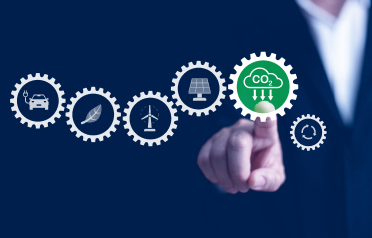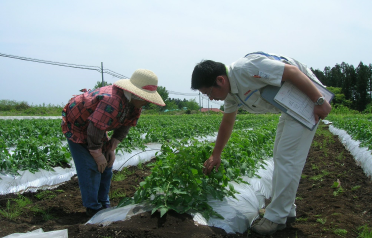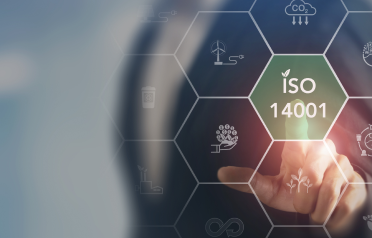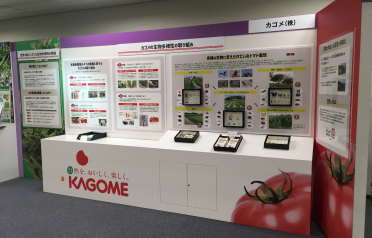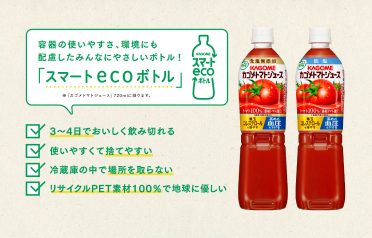



TCFD・TNFD提言への取り組み
自然の恵みを原料とするカゴメグループにとって、気候変動と自然資本の損失は事業の持続的成長に影響を及ぼす重要課題であると認識しています。
当社グループは、相互に関係しあう気候変動課題・自然資本関連課題に対し、リスクや機会を踏まえた上で、事業活動と連動させながら環境課題への包括的な対応とTCFD・TNFDの統合的な開示を進めています。
詳細は、「統合報告書2025」をご覧ください。
The document at this link is available in Japanese only
以下は、「統合報告書2025」で公開している「TCFD・TNFDへの取り組み」の概要となります。
取り組みの進捗
TCFDへの対応
| ・2019年~ | :TCFDシナリオ分析を実施し、事業におけるリスク・機会について開示(一部の部門でプロジェクトを実施) |
| ・2022年 | :TCFD提言への賛同を表明 |
| ・2024年 |
:カゴメグループのバリューチェーン全体に対して気候変動が及ぼす影響を分析・特定 (社内横断的なTCFD更新プロジェクトを発足) |
TNFDへの対応
| ・2024年 |
:2023年に公表されたTNFD提言に従い、TNFDの対応を開始。初開示 (TNFD初年度として、事業活動において最も重要な「トマト」に限定) |
TCFD・TNFDの一般要件
| ①マテリアリティの適用 | カゴメグループは気候変動において、シングルマテリアリティを採用し、気候変動リスク・機会による当社グループへの財務影響算定を行っています。また、自然資本ではダブルマテリアリティを採用し、環境・社会へのインパクトも重視して評価を行っています。 |
|---|---|
| ②開示スコープ | 当社グループによる直接操業、及びバリューチェーン上流、下流を対象としています。直接操業では、国内外子会社のすべての生産工場を含みます。バリューチェーン上流では当社グループの中核事業であるトマト事業に着目し、グローバルで産地まで追跡し、依存とインパクトについて分析しています。バリューチェーン下流では消費者を含め、パッケージの廃棄・リサイクルについても分析対象としています。 |
| ③自然関連課題のロケーション | トマトに関連する当社グループの全事業を対象とし、生鮮事業14拠点(国内菜園(直轄、契約))、及び加工事業256拠点(国内工場(食品製造、農場)、海外工場(食品製造、農場)、国内委託加工、海外サプライヤー(二次含む))の計270拠点を確認したところ、自然資本関連の課題の所在として日本の菜園、農場、ポルトガル、アメリカ、オーストラリアの3ヶ国の農場、工場を優先地域に特定しています。 |
| ④他のサステナビリティ課題との統合 | 当社グループの事業活動において、気候変動課題、自然資本関連課題は相互に関連していると認識しています。特に自然資本関連の対応策のうち、原材料や容器包装の調達や最適なトマト栽培システムの開発・確立と運営については、気候変動リスク・機会への影響が大きいと考え、今後の当社グループの戦略、指標と目標についても一体的に捉えた活動を進める予定です。 |
| ⑤時間軸 | 分析の時間軸として、短期は中期経営計画の最大4年間、中期は次期長期ビジョン終了年2035年、長期は2050年としています。 |
| ⑥ステークホルダーとのエンゲージメント | 地域コミュニティや先住民を含めたステークホルダー・エンゲージメントの重要性を認識しております。現在、品質・環境方針、カゴメグループ人権方針の考えに沿った、カゴメCSR調達方針及びカゴメサプライヤーCSR行動指針に基づき、国内/海外原料の調達先に対し、デューデリジェンスの取組みを開始しています。今後もステークホルダーとのエンゲージメントを通じて得た知見を企業経営に活かし、環境課題に関する取り組みを進めていきます。 |
概要
ガバナンス(TCFD/TNFD共通)
取締役会は、経営会議及びサステナビリティ委員会を監督しています。経営会議は、サステナビリティ委員会からの報告を受けて、当社グループの経営方針や戦略を審議し執行しています。また、サステナビリティ委員会とISO14001に則った環境マネジメントシステムとの連携によって、当社グループのガバナンス体制を構築しています。
戦略:気候変動に関するシナリオ分析(TCFD)
リスク・機会の特定
TCFDのシナリオ分析をこれまでの「2℃」及び「4℃」シナリオから、「1.5℃」及び「4℃」シナリオに変更し、気候変動が事業に与えるリスクと機会を特定しました。
・気候変動に関するリスク・機会の一覧
| 大分類 | 気候変動 リスク・機会 | 影響度 | 発現時期 | |
|---|---|---|---|---|
| 移行リスク | 1. 炭素税導入による炭素税の支払いの増加 | 小 | 短~中期 | |
| 2. 炭素税の導入による購入した製品サービスや輸送に関わる調達コストの増加 | 大 | 短~中期 | ||
| 3. GHG排出量削減のための最新技術・設備投資の増加 | 小 | 短~中期 | ||
| 4. 容器包装規制の対応費用の増加 | 小 | 短~中期 | ||
| 5. 電力・エネルギー価格の高騰によるコストの増加 | 中 | 短~長期 | ||
| 物理的リスク | 急性 | 6. 極端な気象現象の増加(工場浸水時の想定損害額や大雨・洪水等の工場不稼働に伴う利益の逸失) | 中 | 短~中期 |
| 7. 降水パターンの変化(渇水による水価格の高騰) | 小 | 短~中期 | ||
| 慢性 | 8. 降水パターンの変化(地下水位低下による生産コストの増加) | 小 | 短~中期 | |
| 9. 気温上昇によるトマト収量減による調達コストの増加 | 大 | 短~長期 | ||
| 10. 高温による農業従事者の生産性の低下に伴う調達コストの増加 | 大 | 短~長期 | ||
| 機会 | 1. 輸送効率化によるコストの削減 | 小 | 短~中期 | |
| 2. 容器包装の資源効率化によるコストの削減 | 小 | 短~中期 | ||
| 3. 肥料・水使用量の削減によるコスト削減、開発利用・外販による売上の増加 | 小 | 短~中期 | ||
| 4. サステナブル製品・低炭素製品の開発・販売による売り上げの増加 | 小 | 短~長期 | ||
| 5. 事業活動の多様化による売り上げ機会の増加 | 大 | 短~長期 | ||
※分析の時間軸として、短期は中期経営計画の最大4年間、中期は次期長期ビジョン終了年2035年、長期は2050年としています。
※TCFDにおける物理的リスクでは平均気温上昇幅に応じたIPCCの各SSPシナリオ、移行リスクでは主にIEAのNZEシナリオを参照しています。
※影響度は「小」を20億円未満程度、「中」を20~50億円程度、「大」を50億円以上を目安としています。
リスク・機会による財務影響とその対応策
特定したリスク・機会に対し、「気候変動(GHG・炭素税)」「持続可能な農業」「水」「サステナブル製品・事業活動の多様化」に分け、影響度が大きい項目、算定可能な項目の財務影響を算定し、さらに、プロジェクトにて各バリューチェーンの対応策を検討しました。
①気候変動(GHG・炭素税)
| リスク・機会認識 | 炭素税やエネルギー価格変動 |
|---|---|
| 財務影響 |
・炭素税導入による支払いコストの増加(2030年) 1.5℃シナリオ:18.7億円 4℃シナリオ:16.1億円 ・炭素税導入による調達コストの増加(2030年) 1.5℃シナリオ:222億円 4℃シナリオ:190億円 |
| 対応策 |
・アクション①省エネルギー・新エネルギー導入 ・アクション②再生可能エネルギー電力への切替 ・アクション③サプライヤーとの協働や輸送効率アップによるGHG排出量削減活動の推進 |
②持続可能な農業
| リスク・機会認識 | 気温上昇による農産物への影響 |
|---|---|
| 財務影響 |
・気温上昇によるトマトの収量変化(2035年) 1.5℃シナリオ:61億円 4℃シナリオ:71億円 |
| 対応策 |
・アクション①トマトにおける品質の維持のための栽培技術・品種開発 ・アクション②調達量の維持拡大 |
③水
| リスク・機会認識 | 水害、渇水による影響 |
|---|---|
| 対応策 |
・アクション①国内工場の取水量削減 ・アクション②海外工場の取水量削減 |
④サステナブル製品・事業活動の多様化
| リスク・機会認識 | サステナブル製品の開発・販売、事業活動の多様化 |
|---|---|
| 財務影響 |
・災害用などの長期保存可能な野菜商品の売上増加(2035年) 1.5℃(2℃)シナリオ:7.3億円 4℃シナリオ:10.5億円 |
| 対応策 |
・アクション①サステナブル製品の開発・環境配慮容器包装 ・アクション②事業活動の多様化 |
戦略:自然関連に関するLEAPアプローチ(TNFD)
カゴメグループ売上の多くを占める「トマトに関連する事業」を対象範囲として、自然への依存とインパクト、及びリスクと機会をTNFDフレームワークのLEAPアプローチによって評価しました。
(0)スコーピング(重点領域の選定)
トマトに関連する当社全事業を分析対象としました。
・ 生鮮事業:国内菜園(直轄、契約)
・ 加工事業:国内工場(食品製造、農場)、海外工場(食品製造、農場)、国内委託加工、海外サプライヤー(二次含む)
(1)Locate(自然との接点の発見)
生鮮事業14拠点、及び加工事業256拠点の計270拠点における事業の自然との接点を、分析ツールを用いて確認し、トマト購入金額やトマト関連製品生産金額等の重要度も踏まえ、優先地域を特定しました。
(2)Evaluate(依存とインパクトの分析)
優先地域、かつ分析ツールにてリスクが「Very high」となった指標の依存とインパクトについて詳細分析を実施しました。
(1)優先地域と(2)優先地域における依存・インパクトの特定
| 優先地域 | 依存 | インパクト | ||
|---|---|---|---|---|
| 国 | 区分 | 拠点詳細 | ||
| 日本 | 菜園、農場 | 国内菜園12拠点、国内農場5拠点 | 良質な水、良質な土壌 | 森林破壊、保護区・保全地域への影響、地域の花粉媒介への影響 |
| ポルトガル | 農場 | 6都市・町:Beja、Evora、Leiria、Lisboa、Santarem、Setubal | 水の供給、良質な水、良質な土壌 | 農地拡大・河川の利用による自然の変化、森林破壊、保護区・保全域への影響、地域の花粉媒介への影響 |
| 工場 | 2工場:FIT、Italagro | |||
| アメリカ | 農場 | 1州:California | 良質な水、良質な土壌 | 農地拡大・河川の利用による自然の変化、森林破壊、保護区・保全地域への影響、地域の花粉媒介への影響 |
| 工場 | 2工場:Ingomar、KIU | |||
| オーストラリア | 農場 | 2州:New South Wales、Victoria | 水の供給、良質な水、良質な土壌 | 農地拡大・河川の利用による自然の変化、保護区・保全地域への影響、重要な生物多様性地域への影響 |
| 工場 | 1工場:KAU | |||
(3)Assess(リスクと機会の特定)
Locate・Evaluateの結果を中心に、食品・農業セクターガイダンスやTCFDの結果も参考にしながらリスクと機会を特定しました。
自然関連リスク・機会の一覧
| 移行リスク | 政策と法 | 1. 農薬規制によるトマト収量の減少、調達コストの増加 |
|---|---|---|
| 2. 森林からトマト畑への土地利用変化により発生したGHG排出量削減コストの増加 | ||
| 3. 先住民族や地域コミュニティとのエンゲージメント失敗による事業機会の喪失 | ||
| 4. バージン食品包装からリサイクル食品包装への代替など、容器包装規制への対応に伴う調達コストの増加 | ||
| 技術 | 5. 生物多様性の危機への対応のための最新技術・設備投資の増加 | |
| 市場 | 6. 農業就業人口の減少に伴う耕作地の荒廃、生物多様性への認知度や対応の低下 | |
| 評判 | 7. トマトの栽培に伴う生物多様性への影響によるブランドイメージの低下 | |
| 物理的リスク | 急性 | 8. 病害虫発生などによる生産量の減少 |
| 慢性 | 9. 過剰な施肥に伴う土地の健全性低下、及びトマト収量の減少 | |
| 10. 河川などにおける富栄養化による生物多様性の低下 | ||
| 機会 | 製品とサービス | 1. 植物残渣(トマトの茎など)のアップサイクル・製品化による売上の増加 |
| 市場 | 2. 農薬リスクを減じたサステナブルな農業で生産したトマトによるブランド価値の向上 | |
| 評判 | 3. 在来種・外来種対応によるブランドイメージの向上 |
(4)Prepare(対応策の検討、開示)
Assessで特定した「リスクと機会」に紐付けながら、対応策を整理しました。
| 対応戦略 : |
「 日本の生物多様性を脅かす4つの危機(生物多様性低下の要因)」を踏まえ、日本のみでなく当社グループが関係する各国の周辺地域に対して 自然を保全し、回復させる活動を拡大する |
| アクション: | トマトの栽培を通じて関わる菜園・農場及びその周辺地域と、トマトを加工し製品化する工場及びその周辺地域において自然を保全し、回復する |
| No | リスク・機会紐付け | 自然関連 対応策 |
|---|---|---|
| 1 |
リスクNo.4 機会No.1 |
原材料・容器包装の調達、プラスチック包材や食品廃棄物の削減におけるサプライチェーン全体での持続可能な 運用の実現に向けた取り組みの推進 |
| 2 |
リスクNo.1, 2, 5, 7, 8, 9, 10 機会No.2, 3 |
最適なトマト栽培システムの開発・確立と運営 (水、肥料、農薬使用量の削減、トマト品種の改良、循環型農業の展開) |
| 3 |
リスクNo.3, 6, 7 機会No.3 |
自治体や地域コミュニティ、生物多様性の主流化、農業従事者などの支援、在来植物の植栽、保全活動への支援 |
| 4 | 基本全てのリスク・機会に紐づく | 生物多様性行動計画(BAP)の計画的な推進、第三者認証の取得拡大 |
リスク管理(TNFD/TNFD共通)
リスク管理の統括機関として、社長を委員長とし、CROを委員会事務局長とする「リスクマネジメント統括委員会」を設置し、リスクの対応方針や課題について、優先度を選別・評価し迅速な意思決定を図っています。また、顕在化したリスクの予防・対応のためのリスクマネジメント活動に対し、経営戦略を踏まえた統合的視点から統括しています。
気候変動リスク、自然関連リスクについても重要課題と認識し全社的なリスクマネジメント体制に統合して管理し、サステナビリティ委員会、経営会議にてリスク管理の進捗確認や、次のステップへの移行判断を行います。
指標と目標(目標年度:2030年度)
目標・対応策を、2025年度中に策定予定の次期中期経営計画及びカゴメ環境マネジメント計画(2026年~2028年)に活用・反映させることで、レジリエンスの向上を目指していきます。
(緩和)
・ Scope1,2において温室効果ガスの排出量を42%以上削減する(2020年対比)
・ Scope3において温室効果ガスの排出量を13%以上削減する(2020年対比)
・ 飲料PETのリサイクル/植物由来素材を50%以上にする
・ 紙容器飲料の石油由来素材ストロー使用をゼロにする
(適応)
・ 高温耐性品種への改良(栽培技術・品種開発)を1件以上行う
・ 乾燥耐性品種の開発、節水・減肥栽培技術の導入を1件以上行う
・ 国内工場の水使用量原単位を9%以上削減する(2021年対比)



